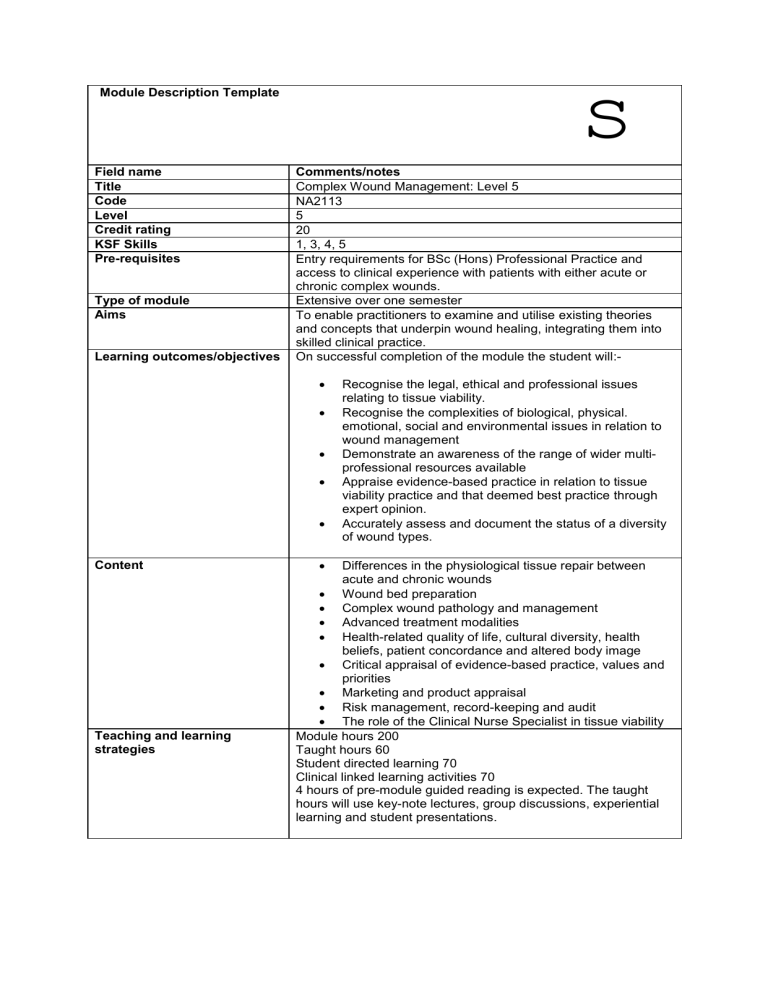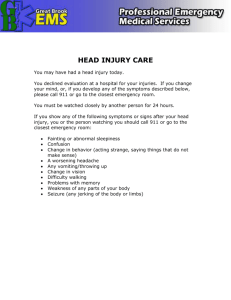Theoretical assessment: Weighting 50%

Module Description Template s
Field name
Title
Code
Level
Credit rating
KSF Skills
Pre-requisites
Type of module
Comments/notes
Complex Wound Management: Level 5
NA2113
5
20
1, 3, 4, 5
Entry requirements for BSc (Hons) Professional Practice and access to clinical experience with patients with either acute or chronic complex wounds.
Extensive over one semester
Aims To enable practitioners to examine and utilise existing theories and concepts that underpin wound healing, integrating them into skilled clinical practice.
Learning outcomes/objectives On successful completion of the module the student will:-
Recognise the legal, ethical and professional issues relating to tissue viability.
Recognise the complexities of biological, physical. emotional, social and environmental issues in relation to wound management
Demonstrate an awareness of the range of wider multi-
Content professional resources available
Appraise evidence-based practice in relation to tissue viability practice and that deemed best practice through expert opinion.
Accurately assess and document the status of a diversity of wound types.
Differences in the physiological tissue repair between acute and chronic wounds
Wound bed preparation
Complex wound pathology and management
Advanced treatment modalities
Health-related quality of life, cultural diversity, health beliefs, patient concordance and altered body image
Critical appraisal of evidence-based practice, values and priorities
Marketing and product appraisal
Risk management, record-keeping and audit
The role of the Clinical Nurse Specialist in tissue viability
Teaching and learning strategies
Module hours 200
Taught hours 60
Student directed learning 70
Clinical linked learning activities 70
4 hours of pre-module guided reading is expected. The taught hours will use key-note lectures, group discussions, experiential learning and student presentations.
Learning support The student will be offered pre-module guided reading.
Indicative reading:
Key Journals :
Journal of Wound Care
Journal of Tissue Viability
Wounds UK
British Journal of Nursing (Tissue Viability supplement)
The Diabetic Foot
Key Texts :
Benbow , M. 2005. Evidence Based Wound Management.
London: Whurr Publishers.
Cherry, G.W., K.G. Harding and T.J. Ryan. (ed). 2001. Wound
Bed Preparation.
London: Royal Society of Medicine Press.
Clark, M. 2004. Pressure Ulcers: Recent Advances in Tissue
Viability. Salisbury: MA Healthcare.
Dealey, C. 2005. The Care of Wounds – A Guide for Nurses . 3 rd ed. Oxford: Blackwell Publishing.
Dunford, C. & B. Gunnewicht. 2003. Fundamental Aspects of
Tissue Viability . Salisbury: Quay Books .
Morison, MJ., L.G. Ovington and K. Wilkie. 2004. Chronic Wound
Care: a Problem-Based Learning Approach.
Oxford: Mosby.
Naylor, W., D. Laverty and J. Mallett. (ed). 2001. Wound
Management in Cancer Care. Oxford: Blackwell Science Ltd.
Ousey, K. 2005. Pressure Area Care . Salford: Blackwell
Publishing.
Rainey, J. 2002. Wound Care – A Handbook for Community
Nurses . London: Whurr Publishers.
White, R. (ed). 2002. Trends in Wound Care.
Wiltshire: Quay
Books MA Healthcare Ltd.
White, R. (ed). 2003. Trends in Wound Care – Volume II.
Wiltshire: Quay Books MA Healthcare Ltd.
White, R. (ed). 2004. Trends in Wound Care – Volume III.
Wiltshire: Quay Books MA Healthcare Ltd.
White, R. (ed). 2006. Trends in Wound Care – Volume IV.
Wiltshire: Quay Books MA Healthcare Ltd.
White, R.J. (ed). 2003. The Silver Book.
Wiltshire: Quay Books
MA Healthcare Ltd.
Key Web Sites: www.worldwidewounds.com
www.burnsurgery.org
www.nice.org.uk
www.bu.edu/woundbiotech/woundcare www.zoobiotic.com
www.wounds-uk.com
www.patient.co.uk
www.epuap.com
www.ewma.org
Assessment tasks There are two elements to the summative assessment.
A 40% pass must be achieved in both assessment parts to achieve an overall pass for the module
Theoretical assessment: Weighting 50%
Students will submit a 2500 word essay choosing one of the two areas identified below.
Either:
a patient care study which demonstrates application of theory and evidence based practice to the nursing management of a patient with a wound.
Or:
produce an in-depth study which includes a discussion evaluating evidence relating to one aspect of wound management to be agreed with the module leader.
Clinical link learning activities: Weighting 50%
Students will complete 2 out of 8 clinical link learning activities.
Maximum 500 words per activity (1000 words total).
Identify a patient whose health belief impacts on concordance with treatment. Make critical notes to identify key issues as related to professional accountability and provision of care.
Select a patient with an altered body image as the result of trauma, disease or surgery. Identify the 2 major issues for the client and discuss the nursing response with appropriate rationale.
Identify a patient with a complex wound. Make critical notes on current resources and how this impacts on the nurse’s ability to implement national guidelines.
Select a patient at risk of pressure damage. Use 2 pressure area risk assessment tools to categorise the level of risk. Evaluate the strengths and weaknesses of each tool as applied to the patient.
Choose a patient with a complex wound, where other members of the multidisciplinary health care team are involved. Make critical notes on the communication strategies between team members.
Choose 2 patients with complex wounds. Undertake an assessment using a wound assessment tool and compare the information gathered by this method to the information documented in the client’s nursing and medical notes.
Identify a complex wound which is failing to progress.
Make critical notes on the underlying aetiology that might contribute to the non-healing status.
Select a patient with a complex wound with a wound infection or critical colonization. Briefly itemise the infection control strategies to protect the patient and
others.
Brief description of module content and/or aims
(maximum 80 words)
This module will enable the student to meet the clinical challenge of caring for the patient with a complex wound, recognising the multidimensional nature of healing and the variables that may influence the provision of care.
AEB Undergraduate Continuing Professional Education. Area examination board to which module relates
Module team/authors/coordinator
Semester offered, where appropriate
Site where delivered
Date of first approval
Date of last revision
Date of approval of this version
Version number
Replacement for previous module
Field for which module is acceptable and status in that field
Course(s) for which module is acceptable and status in that course
School home
External examiner
Karen Penhallow, Wound Care Nurse Specialist, Module Leader;
Terry Shipperley Clinical Nurse Specialist – Tissue Viability
Claire Martin Wound Care Nurse Specialist
One.
Falmer
26/11/2010
1
Tissue Viability - NH213
Nursing: Optional/mandatory
BSc (Hons) Professional Practice - optional/mandatory.
SNM
Maureen Benbow (expires September 2009)






